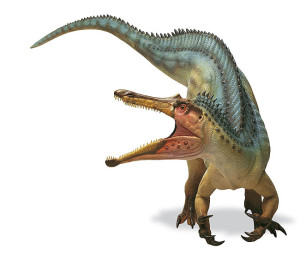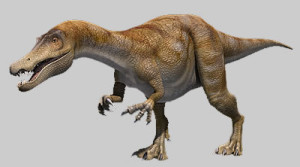Updated on: 29/03/2022
Baryonyx is an extinct genus of theropod dinosaur that lived around 130–125 million years ago. Baryonyx, recognized as a member of the family Spinosauridae, was a small relative of Spinosaurus and Suchomimus.
| Kingdom: | Animalia |
| Phylum: | Chordata |
| Order: | Saurischia |
| Suborder: | Theropoda |
| Family: | Spinosauridae |
| Subfamily: | Baryonychinae |
| Genus: | Baryonyx |
| Species: | B. walkeri (Type Species) |
| Name Meaning: | Heavy claw |
| Pronunciation: | Bah-ree-on-ix. |
| Geological Time Period: | Early Cretaceous Period |
| Size: | Length – 7.5 m (25 ft) Height – 2.5 m (8 ft) |
| Claw size: | 20 to 30 cm |
| Skull length: | 1.2 m (4ft) |
| Weight: | 2400 lbs (1.3 short tons) |
| Range/Location: | United Kingdom and Iberian Peninsula (aka Iberia) |
| Diet: | Carnivore |
| Habitat: | Semi-aquatic environment |
| Birth type (Reproduction): | Eggs |
| Locomotion: | Bipedial (arguably quadrupedal) |
On 7th January, 1983, William John Walker, an amateur fossil hunter, found a phalanx bone, part of a rib and a large claw, in Smokejacks Pit in Surrey, England. British paleontologists Angela C. Milner and Alan J. Charig found more skeletal remains on the site a month later. And, the entire skeleton was unearthed in June. The skeleton consisted of partial skull bones; cervical, dorsal and caudal vertebrae; teeth; ribs; arm and hand bones; claws; sternum; coracoids; hip bones and leg bones. The original specimen (NHMUK VP R9951) is the most complete theropod skeleton found in the United Kingdom. In 1986, Angela C. Milner and Alan J. Charig assigned the specimen to a new genus and species – Baryonyx walker. Fragmentary remains, assigned to this genus, have been found in Portugal, Spain and Isle of Wight.
Baryonyx had long, narrow jaws similar to that of the gharial. They possessed 96 small, serrated teeth (almost twice as many as T. Rex). It has a crest on its snout. Unlike other theropod dinosaurs, Baryonyx had a long and straight neck. It had two arms with large claws, two legs and a long tail.
The genus name, Baryonyx, has come from ancient Greek words βαρύς (barys) meaning “strong” or “heavy”, and ὄνυξ (onyx) meaning “talon” and “claw”. The name “walkeri” (belonging to the type species Baryonyx walker) is given honoring its first discoverer William J. Walker.

Baryonyx is the first known piscivorous dinosaurs as evidenced by fish scales found in the stomach of the holotype specimen. It also had bones of juvenile Iguanodon triggering a lot of people to believe that they were an active predator (and scavenger).

They lived near water bodies. In their first paper, Charig and Milner speculated that Baryonyx probably crouched on riverbanks to gaff fish out of the water. They also added that it was not an aquatic creature, but they were good swimmers like most land vertebrates. It is believed that, in land, they caught their prey with their forelimbs using their large claws.